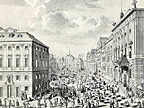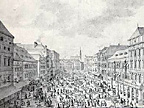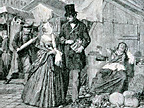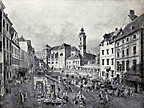The Old Markets in the City Centre - History
Hoher Markt |
Neuer Markt |
Am Hof |
Freyung
The origins of the Viennese markets can be traced back to about 1150 when the Babenberg royal seat was moved to Vienna. The settlement thus received the decisive impetus to grow dramatically. About 70 years later, in 1221, Duke Leopold VI granted Vienna privileges of a city. Simultaneously with the first city privileges Vienna was also granted trading privileges: traders passing through the city had to lay out their goods and offer them for sale.
As the city developed further and the early medieval barter economy was replaced by an economy based on the division of labour, the needs for food and goods of everyday use changed. Bustling markets were established on all important squares of today's city centre during the Middle Ages. Furthermore, numerous mobile stands were set up in other streets and squares. Some of today's street names still point to their former use as a market place, such as Hoher Markt (forum altum, high market), Neuer Markt (novum forum, new market), Bauernmarkt (Pawrnmarckt, farmers' market), Fleischmarkt (carnifices Wiennensis, Viennese meat market), Getreidemarkt (Traitmarckt, cereals market), Kohlmarkt (charcoal, originally Witmarckt = for firewood). Wildpretmarkt (Wildbret = game) is an exception because it was pinewood spill that was sold there as a cheap means for illumination. Only in the 19th century did a trader of game settle there.
Hoher Markt
 A document written in 1208 mentions Marckt zu Wienn for the first time. Researchers agree that this "market of Vienna" can only refer to Hoher Markt. In 1223 the market place which is considered to be Vienna's oldest market is referred to as forum altum.
A document written in 1208 mentions Marckt zu Wienn for the first time. Researchers agree that this "market of Vienna" can only refer to Hoher Markt. In 1223 the market place which is considered to be Vienna's oldest market is referred to as forum altum.
Documents from the year 1282 indicate that the city's fish market was held at the location of Hoher Markt. From the beginning of the 14th until the 15th century, there was also trade in bread which took place on the bakers' "bread tables" in today's area of orientation numbers 10 and 11. Other merchandise such as animal fat, pork fat, tallow, beeswax, textiles and shoes, were also sold at medieval Hoher Markt. In the course of the 15th century, the sale of crafts decreased as the craftsmen and skilled manual workers began to sell their products in their own workshops. In August 1753, a decree ordered the move of the fish market from the city to the banks of the Danube (Central Fish Market). Although Hoher Markt was less attractive after the transfer of the fish market and fewer traders offered their goods for sale there, it existed until 1939 as a weekly market.
Neuer Markt
 Soon Hoher Markt became too small to provide for the city with its rapidly growing population. It was extended to Neuer Markt, which was first mentioned in 1234 under the name of novum forum.
Soon Hoher Markt became too small to provide for the city with its rapidly growing population. It was extended to Neuer Markt, which was first mentioned in 1234 under the name of novum forum.
The medieval trade centre for greens and meat soon developed into a market for grains, flour and pulses. Already in 1345 the documents referred to a melgroube, a house for the storing of flour known from other cities with an intact medieval centre. The five-story building was erected by the city in 1453 and existed until 1697. At the beginning of the 19th century, the millers were still the majority of market stand operators. Only with the growing competition of new mills in the east of Vienna - which received their grains and flour per ship and sold it at another location referred to as Schanzl -, did the flour and grain market in the city centre slowly lose its meaning. In the 19th century, Neuer Markt changed into a simple victuals market. The term "Mehlmarkt" - flour market - however, remained in common use and was only forgotten in the times of the First Austrian Republic (1918 - 1934).
Am Hof
 Around 1280 the square known as Am Hof was transformed into a market place after the Habsburgs had moved from the old Babenberg royal seat at the Platz Am Hof to their newly erected seat in the area of today's Hofburg Palace. In the 14th century, the sea fish and crustacean market was established at Am Hof. The city's rent book of the year 1814 alludes to the fact that sea fish was no longer to be sold at the fish market (Hoher Markt) but rather at Vischmarkt am Hof. Other edibles such as fruit, vegetables, bread, cakes and pastries were still traded at Am Hof though.
Around 1280 the square known as Am Hof was transformed into a market place after the Habsburgs had moved from the old Babenberg royal seat at the Platz Am Hof to their newly erected seat in the area of today's Hofburg Palace. In the 14th century, the sea fish and crustacean market was established at Am Hof. The city's rent book of the year 1814 alludes to the fact that sea fish was no longer to be sold at the fish market (Hoher Markt) but rather at Vischmarkt am Hof. Other edibles such as fruit, vegetables, bread, cakes and pastries were still traded at Am Hof though.
Intending to revise the market structures in Vienna, the government's decree from 1753 stipulated the transfer of the greens market to Schanzl. Fifteen years later the fish market was moved to the Viennese Danube Canal. Bread, cakes and pastries continued to be sold at Am Hof. Almost up to World War II a fruit market was held there and a few times Platz Am Hof also hosted the Christmas Market.
Nowadays the antiques market takes place on the weekends from March to Christmas.
Freyung
 In the Late Middle Ages, a horse market was held once a week at Freyung close to the Schottenkloster, the Monastery of the Scottish Friars. Only during the 18th century did a victuals market for fruit, vegetables and herbs develop at that location.
In the Late Middle Ages, a horse market was held once a week at Freyung close to the Schottenkloster, the Monastery of the Scottish Friars. Only during the 18th century did a victuals market for fruit, vegetables and herbs develop at that location.
The Benedictine monks, however, were disturbed by the hustle and bustle in front of their monastery and worked towards the removal of the market stands. In 1780 the fruit and vegetable vendors moved to the Freihaus auf der Wieden (today's area of Wiedner Hauptstraße-Resselgasse-Operngasse), where the precursors of Naschmarkt emerged. In 1822 the renovation of the cladding of the church Schottenkirche served as a pretext to transfer the remaining stands of the "Dürrkräutlerinnen" (women selling herbs) and the basket makers. But this was not the end of Freyung as a market place: a few centuries later, a market for high-quality greens was established there. A report from the year 1871 speaks of a dozen vendors selling "… delicious vegetables, asparagus, beautiful grapes, savoury peaches and other fruits for dear money…". During the Austro-Hungarian Empire's last peaceful years, a daily victuals market was held between Tiefer Graben and Renngasse as well as around the Austria fountain. In the years of the First Austrian Republic (1918-1934), the market was moved to the other side of the square in front of the former building of the Hungarian National Bank (Palais Ferstel) and Palais Harrach. In order to beautify the cityscape, the market received new, uniform market stands in 1925.
Since 1990 the Freyung has again served as a market place for food several days a week.
© Photos: Municipal Department 59
Contact for this page:City of Vienna | Market Authority
Contact form
